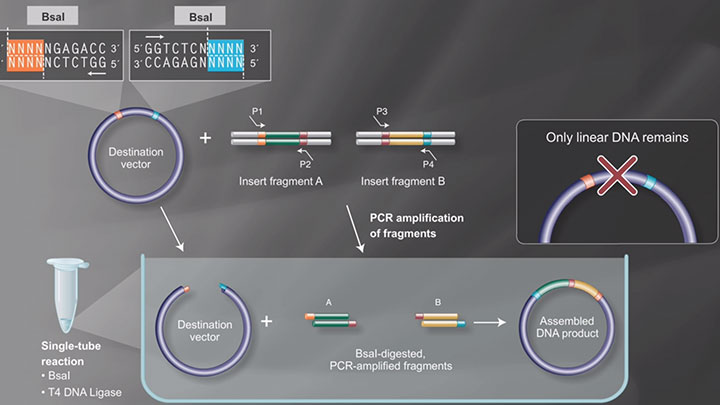Restriction Enzymes in Golden Gate Assembly
Script
What is the role of restriction enzymes in Golden Gate Assembly?
Becky Kucera:
Restriction enzymes are absolutely critical to Golden Gate Assembly function, but it can't just be any restriction enzyme, it has to be a Type II S restriction enzyme. You'll remember that the traditional type II restriction enzyme, like EcoR1 has a recognition site that it binds and cuts within that sequence.
Type II S enzymes are a little bit different. Type II S enzymes have a recognition and binding site but then they reach downstream and cut further from that recognition site.
Once all of the fragments of DNA that are going to be part of the final assembly have been cut by a Type II S restriction enzyme, the recognition sequence is on a separate piece of DNA and the pieces of interest are flanked by nice, four-base overhangs that are going to anneal to the next fragment in the assembly because they have a complimentary four-base overhang. This process goes on and on until the entire assembly is made.
Now, a fair question to ask is, why after cutting doesn't the site get ligated by the DNA ligase to reform the original sequence? Well, that can happen and it does happen but it's okay, because when that happens it's reformed the substrate for the Type II S enzyme to come in once more and cut and generate those important four-base overhangs. So every time those overhangs are formed, there's a 50% chance that it's going to anneal to and be ligated to its complimentary four-base overhang in the next fragment as opposed to just non-productively reforming the original DNA sequence.
What's important is, all of the fragments that are going to go in the assembly have four-base overhangs that guide the assembly and the restriction enzyme site needed for further cutting is on a separate piece of DNA. And all the DNA, once it is part of the assembly, is protected from further cutting. It can't help but accumulate with time and ends up seamlessly part of your destination construct.
What is the future of restriction enzymes in Golden Gate Assembly?
Oh, I think we're still in the discovery phase in terms of what Golden Gate Assembly can really do. Whether it's discovering new Type II S restriction enzymes that have superior turnover rates or better catalytic functions or just fine-tuning the ones that have already been discovered, we still have lots that can be done.
You got to remember that it wasn't that long ago before 3- or 4-fragment ligations were something to be celebrated and now we have literature publications where people have had 20-fragment Golden Gate Assemblies, that's just amazing. But, is that a final barrier that will never be broken? I doubt it. I think it will be broken through just the way the four-minute mile barrier was broken.
View Type IIS enzymes for Golden Gate at www.neb.com/TypeIISTable
Related Videos
-

What is a Type II Restriction Enzyme? -

Discovering New Restriction Enzymes -

Golden Gate Assembly Workflow -

Golden Gate Assembly Tool Tutorial

